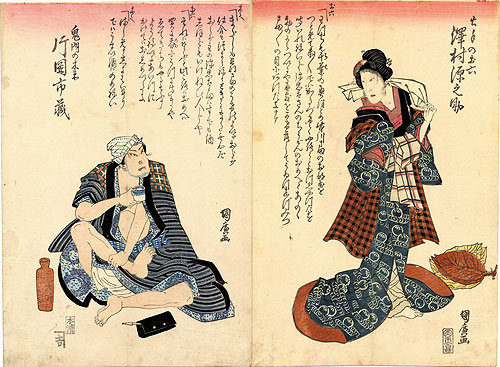Having a drink in Ukiyo-e
September 7 (Mon), 2015 – December. 6 (Sun), 2015
This museum mainly exhibits Ukiyo-e prints and paintings produced in Osaka in the Edo period. Most Ukiyo-e paintings made in Osaka were of portraits of actors playing kabuki in theatres around Dotombori area.
In Dotombori area at the time there stood in a row theatres including kabuki theatres. A phrase “Once you arrive in Osaka, you will surely find yourself spending at least few days in theatres.” (from Settsu Meisho Zue) indicates that people enjoyed theatres losing track of time. Iroha jaya (tea house) were also very popular. You can see people enjoying the party in the picture below. (“Yoru-no-kao-mise” from Settsu Meisho Zue.)

This time we exhibit Ukiyo-e prints describing sake in it. You can see in Ukiyo-e prints in which people are drinking sake in kabuki plays, their charming performance of drunkenness, and people exchanging each other’s cups of sake to express their ties. Fully enjoy sake in Ukiyo-e.
 “Osome Hisamatsu ukina-no-yomiuri” by Kunihiro
“Osome Hisamatsu ukina-no-yomiuri” by Kunihiro
Sake in Ukiyo-e
Sake has been brewed down the ages. In the Edo period, people in Edo also drunk sake that was brewed at Itami, Ikeda or Nada (those sake was called kudari-zake).
You can see various scenes of people drinking sake in kabuki plays, drinking vessels are used as stage properties (holding a tokkuri (sake server) or exchanging sakazuki (drinking cup) to pledge loyalty) which you can see in Ukiyo-e.
When the all-star cast show is held, bottles of sake from patrons are piled up in front of the theatre, sake is indispensable for celebration all through the ages.
Here we have selected Ukiyo-e prints which depict sake or drinking vessels. Please look at Japanese tradition and a way of enjoying sake in Ukiyo-e.
Presenting a party and acting of getting drunk
Entertainers play an important role in the party in a kabuki play. At a party in a first-class Japanese restaurant like Ichiriki jaya in “Kanadehon Chushingura”, geisha, traditional Japanese female entertainers, and taikomochi, male geisha, were called in as well as tayu, a high ranking Noh actor, and oiran, a courtesan. Their songs and shamisen (musical instruments) add liveliness and dances add gorgeousness.
Highlight of the party scene is the acting of getting drunk. There are scenes that people dynamically drink sake (as in “Kanjincho”), and there are scenes that Oboshi Yuranosuke pretends to get drunk in order to put the enemy off guard (as the scene at Ichiriki jaya in “Kanadehon Chushingura”). Sake is given an important role in the kabuki story.
Bonds that sakazuki(drinking cup) creates
In religious rituals, sake is used to purify things and to symbolize formality. To make bonds stronger, people exchange their sakazuki as a pledge of friendship. The bride and groom consume sake in a wedding ceremony as a pledge of partnership.
Wedding ceremonies are supposed to be congratulatory, but in kabuki plays there are many tragic stories like “Imoseyama”, in which lovers wish to be united in a future life. In “Ehon Taiheiki”, Mitsuhide’s son goes to the battle front after his own wedding ceremony. In “Miyagino”, Miyagino avenged her father’s death with a help from her fiancée Kanai Tanigoro and then bewedded.
There are also stories as “Sannin Kichisa”, in which people exchange their sakazuki of blood to pledge their comradeship. In “Natsumatsuri Naniwa Kagami”, Danshichi and Tokubei become brothers in spirit by mixing their blood.
In these stories, fateful relationship that sakazuki creates is the pivot which leads the story.
Ukiyo-e that depicts sake
“Benkei and Ushiwakamaru” is known for the famous song starting with “Kyo no Gojo no hashi no ue”. Benkei was defeated by Ushiwakamaru (a childhood name of Minamoto no Yoshitsune) in an attempt to rob the 1000th sword he had been collecting from passing swordsmen and became Yoshitsune’s retainer. The story that Benkei passed Ataka Gate with Yoshitsune is the famous “Kanjincho”. In this story Benkei dared to beat his master Yoshitsune in order to dispel gate guards’ doubt and successfully passed through. Then they drunk up sake they were offered from one of the guards named Togashi, and escaped safely.
Minamoto no Yorimitsu, being assigned by the emperor to slay the giant ogre, Shuten Doji of Mt. Oe, who loves sake, goes to Mt. Oe along with Watanabe no Tsuna, Sakata no Kintoki, Usui no Sadamitsu and Urabe no Suetake. Yorimitsu gets the ogre dead drunk and kills it while it is asleep. Yorimitsu and the four people, known as the big four, also appear in “Tsuchigumo” and “Komochiyamamba”, with their legend being incorporated into kabuki plays.
Enjoy other Ukiyo-e prints that depict sake.